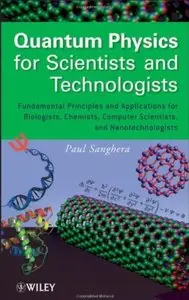Paul Sanghera - Quantum Physics for Scientists and Technologists: Fundamental Principles and Applications for Biologists, Chemists, Computer Scientists, and Nanotechnologists
Published: 20114-04-12 | ISBN: 0470294523 | PDF | 544 pages | 6 MB
Making quantum physics accessible to the non-physicists, Quantum Physics for Scientists and Technologists is a self-contained, cohesive, concise, yet comprehensive story of quantum physics presented for students and professionals in biology, chemistry, material science, engineering, computer science, nanotechnology, and related fields. The fact that all these fields are dealing with the molecules and atoms underlines the increasing need of learning quantum mechanics even in non-physics majors because quantum physics is the science of the micro and nano world of molecules, atoms, subatomic particles, and their behavior in living and non-living systems. Most, if not all, books on quantum physics written for the science students use abstract mathematical formulation of quantum mechanics and leave its implications and connections to the real world often non-intuitive. This kind of framework may be necessary for physics students, but not that important but often is a learning hurdle for non-physics majors.
This book presents comprehensive coverage of quantum theory supported by experimental results and explained through applications and examples is presented without the use of abstract and complex mathematical tools and formalisms such as bra-ket vectors, Hilbert space, matrix algebra, or group theory. Throughout the book, concepts and principles of quantum physics are explained in the language of non-physics majors by presenting examples and applications from non-physics fields including chemistry, biology, nanotechnology, and related fields. The interfaces and connections between quantum physics and non-physics fields such as biology, chemistry, computing, and nanotechnology are exposed or introduced in an easy to understand fashion.
Furthermore, this book takes advantage of the amazing story of how quantum mechanics was developed. The concepts and principles that make the foundation of the quantum theory are developed in context of the history of the gradual development of quantum mechanics, which some of us find as amazing as quantum mechanics itself. This facilitates to introduce the key concepts and principles of quantum physics as explanations to the results of those historic experiments which could not be explained with the classical physics. In doing so, the book illustrates in an interesting way the process of scientific discoveries and advances.



